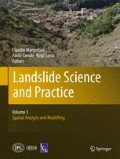Abstract
This paper deals with the theoretical-numerical and experimental analysis of dry rock avalanches moving down a chute.
Depth-averaged field equations of balance of mass and momentum as prescribed by Savage and Hutter (1991) are implemented in the RASH3D code. They describe the temporal evolution of the depth averaged velocity and the distribution of the avalanche depth. A Coulomb-type mechanical behavior of the mass is assumed. To incorporate the curvature effects of the bed, the centripetal acceleration term has been here implemented in the code.
Carried out experiments consist in the release of granular material on an inclined plane that is connected to a horizontal run-out zone through a sharp transition. Comparison of the experimental findings with the computational results proved that neglecting the centripetal acceleration term can have the effect of leading to errors in the determination of the well fitted friction angle. In particular, an overestimation of the computed dynamic friction angle respect to its measured value is observed.
Access this chapter
Tax calculation will be finalised at checkout
Purchases are for personal use only
References
Audusse E, Bristeau MO, Perthame B, (2000) Kinetic schemes for Saint-Venant equations with source terms on unstructured grids. INRIA report 3989, National Institute for research and computational sciences and control, Le Chesnay
Bristeau MO, Coussin B, Perthame B (2001) Boundary conditions for the shallow water equations solved by kinetic schemes. INRIA report 4282, National institute for research and computational sciences and control, LeChesnay
Chen H, Lee CF (2000) Numerical simulation of debris flows. Can Geotech J 37:146–160
Denlinger RP, Inverson RM (2004) Granular avalanches across irregular three-dimensional terrain: 1. Theory and computation. J Geophys Res 109: F01014, 14pp, doi:10.1029/2003JF000085
Mangeney-Castelnau A, Vilotte JP, Bristeau O, Perthame B, Bouchut F, Simeoni C, Yerneni S (2003) Numerical modelling of avalanches based on Saint Venant equations using a kinetic scheme. J Geophys ResSolid Earth 108(B11):2527
Manzella I (2008) Dry rock avalanche propagation: unconstrained flow experiments with granular materials and blocks at small scale. Ph.D. thesis 4032, Ecole Polytechnique Fédérale de Lausanne, Switzerland
Manzella I, Labiouse V (2008) Qualitative analysis of rock avalanches propagation by means of physical modelling of not constrained gravel flows. Rock Mech Rock Eng J 41(1):133–151
Manzella I, Labiouse V (2009) Flow experiments with gravel and blocks at small scale to investigate parameters and mechanisms involved in rock avalanches. Eng Geol 109(1):146–158
McDougall S (2006) A new continuum dynamic model for the analysis of extremely rapid landslide motion across complex 3D terrain. Ph.D. dissertation, University of British Columbia, Canada
McDougall S, Hungr O (2004) A model for the analysis of rapid landslide motion across three-dimensional terrain. Can Geotech J 41:1084–1097
Pastor M, Quecedo M, Gonzalez E, Herreros MI, Fernandez Merodo JA, Mira P (2004) Modelling of landslides: (II) propagation, degradations and instabilities in geomaterials. In: Darve, F., Vardoulakis, I (eds) CISM courses and lectures No. 461, Springer
Pirulli M (2005) Numerical modelling of landslide runout, a continuum mechanics approach. Ph.D. dissertation, Politecnico di Torino, Italy, 204pp
Pisani G, Pirulli M, Labiouse V, Scavia C (in prep.) The role of the centripetal acceleration on the propagation of flow-like landslides on a complex topography
Savage SB, Hutter K (1989) The motion of a finite mass of granular material down a rough incline. J Fluid Mech 199:177–215
Savage SB, Hutter K (1991) The dynamics of granular materials from initiation to runout. Acta Mech 86:201–223
Acknowledgments
The authors wish to thank Anne Mangeney (IPGP, France) and Marie-Odile Bristeau (INRIA, France) for having offered the use of the SHWCIN code and for having helped to solve some fundamental numerical problems.
Author information
Authors and Affiliations
Corresponding author
Editor information
Editors and Affiliations
Rights and permissions
Copyright information
© 2013 Springer-Verlag Berlin Heidelberg
About this chapter
Cite this chapter
Pisani, G., Pirulli, M., Labiouse, V., Scavia, C. (2013). Influence of Bed Curvature on the Numerical Modelling of Unconstrained Granular Materials. In: Margottini, C., Canuti, P., Sassa, K. (eds) Landslide Science and Practice. Springer, Berlin, Heidelberg. https://doi.org/10.1007/978-3-642-31310-3_36
Download citation
DOI: https://doi.org/10.1007/978-3-642-31310-3_36
Published:
Publisher Name: Springer, Berlin, Heidelberg
Print ISBN: 978-3-642-31309-7
Online ISBN: 978-3-642-31310-3
eBook Packages: Earth and Environmental ScienceEarth and Environmental Science (R0)

